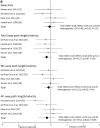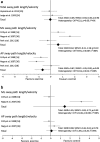Effectiveness of Exercise Interventions to Improve Postural Control in Older Adults: A Systematic Review and Meta-Analyses of Centre of Pressure Measurements
- PMID: 27245061
- PMCID: PMC5215248
- DOI: 10.1007/s40279-016-0559-0
Effectiveness of Exercise Interventions to Improve Postural Control in Older Adults: A Systematic Review and Meta-Analyses of Centre of Pressure Measurements
Erratum in
-
Correction to: Effectiveness of Exercise Interventions to Improve Postural Control in Older Adults: A Systematic Review and Meta-Analyses of Centre of Pressure Measurements.Sports Med. 2018 Jan;48(1):241. doi: 10.1007/s40279-017-0801-4. Sports Med. 2018. PMID: 29052804 Free PMC article.
Abstract
Background: Previous reviews have shown balance in older adults to be improved with exercise. However, it is currently unclear whether postural control, indicated by centre of pressure (COP) measurement, can be improved in older adults and thus whether postural control could be a mechanism to improve balance.
Objectives: The purpose of this systematic review was to assess the effectiveness of force platform COP variables to identify changes in postural control following exercise interventions in older adults. In addition, a secondary purpose was to determine whether the exercise types (balance, resistance or multi-component exercise interventions) are equally effective to improve postural control.
Methods: Randomised controlled trials were identified using searches of databases and reference lists (PROSPERO registration number CRD42014010617). Trials performing exercise interventions, reporting force platform COP measurements, in participants with a mean age of ≥60 years were included. Risk of bias assessments were performed following the Cochrane guidelines. Data were pooled in meta-analyses, and standardised mean differences (SMDs) with 95 % confidence intervals (CIs) were calculated.
Results: Twenty-three trials met the inclusion criteria for the systematic review. Twenty-two trials could be defined as either utilising a balance, resistance or multi-component exercise intervention. These 22 trials were used in the meta-analyses. All trials reported measurements of double leg stance; eight trials reported additional stance conditions. The meta-analyses of double leg stance showed that balance exercise interventions significantly decreased total sway path length/velocity [SMD -1.13, 95 % CI -1.75 to -0.51 (eyes open); SMD -0.79, 95 % CI -1.33 to -0.26 (eyes closed)] and anterior-posterior sway path length/velocity [SMD -1.02, 95 % CI -2.01 to -0.02 (eyes open); SMD -0.82, 95 % CI -1.46 to -0.17 (eyes closed)] in both eyes open and eyes closed conditions. Balance exercise interventions also decreased sway area in eyes closed conditions (SMD -0.57, 95 % CI -1.01 to -0.13) and medio-lateral sway path length/velocity in eyes open conditions (SMD -0.8, 95 % CI -1.48 to -0.12). In contrast, neither resistance nor multi-component exercise interventions affected any of the included COP measurements.
Conclusions: Postural control is improved by balance exercise interventions. In contrast, strength or multi-component exercise interventions did not influence postural control measurements in older adults. In addition, a lack of standardisation in collection protocol and COP variables calculated across trials was identified.
Conflict of interest statement
Compliance with Ethical Standards Funding No sources of funding were used to assist in the preparation of this article. Conflict of interest Daniel Low, Gregory Walsh and Marco Arkesteijn declare that they have no conflict of interest relevant to the content of this review.
Figures






Similar articles
-
Systemic pharmacological treatments for chronic plaque psoriasis: a network meta-analysis.Cochrane Database Syst Rev. 2021 Apr 19;4(4):CD011535. doi: 10.1002/14651858.CD011535.pub4. Cochrane Database Syst Rev. 2021. Update in: Cochrane Database Syst Rev. 2022 May 23;5:CD011535. doi: 10.1002/14651858.CD011535.pub5. PMID: 33871055 Free PMC article. Updated.
-
Interventions for promoting habitual exercise in people living with and beyond cancer.Cochrane Database Syst Rev. 2018 Sep 19;9(9):CD010192. doi: 10.1002/14651858.CD010192.pub3. Cochrane Database Syst Rev. 2018. PMID: 30229557 Free PMC article.
-
Exercise for improving balance in older people.Cochrane Database Syst Rev. 2007 Oct 17;(4):CD004963. doi: 10.1002/14651858.CD004963.pub2. Cochrane Database Syst Rev. 2007. Update in: Cochrane Database Syst Rev. 2011 Nov 09;(11):CD004963. doi: 10.1002/14651858.CD004963.pub3. PMID: 17943831 Updated.
-
Physical activity and exercise for chronic pain in adults: an overview of Cochrane Reviews.Cochrane Database Syst Rev. 2017 Apr 24;4(4):CD011279. doi: 10.1002/14651858.CD011279.pub3. Cochrane Database Syst Rev. 2017. PMID: 28436583 Free PMC article.
-
Efficacy of progressive resistance training on balance performance in older adults : a systematic review of randomized controlled trials.Sports Med. 2008;38(4):317-43. doi: 10.2165/00007256-200838040-00004. Sports Med. 2008. PMID: 18348591
Cited by
-
Sarcopenia Associated with Chronic Obstructive Pulmonary Disease.J Bone Metab. 2019 May;26(2):65-74. doi: 10.11005/jbm.2019.26.2.65. Epub 2019 May 31. J Bone Metab. 2019. PMID: 31223602 Free PMC article. Review.
-
Advantages and problems of nonlinear methods applied to analyze physiological time signals: human balance control as an example.Sci Rep. 2017 May 26;7(1):2464. doi: 10.1038/s41598-017-02665-5. Sci Rep. 2017. PMID: 28550294 Free PMC article.
-
Infant movement classification through pressure distribution analysis.Commun Med (Lond). 2023 Aug 16;3(1):112. doi: 10.1038/s43856-023-00342-5. Commun Med (Lond). 2023. PMID: 37587165 Free PMC article.
-
The Relationship of Depression Level and Physical Activity with Postural Control in Geriatric Individuals.Noro Psikiyatr Ars. 2023 Aug 21;60(4):356-362. doi: 10.29399/npa.28217. eCollection 2023. Noro Psikiyatr Ars. 2023. PMID: 38077843 Free PMC article.
-
Best-Compromise Control Strategy Between Mechanical Energy Expenditure and Foot Clearance for Obstacle-Crossing in Older Adults: Effects of Tai-Chi Chuan Practice.Front Bioeng Biotechnol. 2021 Dec 2;9:774771. doi: 10.3389/fbioe.2021.774771. eCollection 2021. Front Bioeng Biotechnol. 2021. PMID: 34926422 Free PMC article.
References
Publication types
MeSH terms
LinkOut - more resources
Full Text Sources
Other Literature Sources
Medical
Miscellaneous

